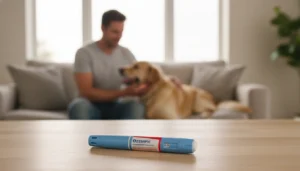What Is the Dosage of Ozempic for Weight Loss?

When it comes to weight loss, the journey can often feel daunting. We understand that many individuals seek effective solutions that not only help them achieve their weight loss goals but also promote overall health and well-being. One of the medications that has gained significant attention in recent years is Ozempic (semaglutide). Originally developed to manage blood sugar levels in adults with type 2 diabetes, Ozempic has also shown promise in supporting weight loss. However, determining the appropriate dosage for weight loss can be complex and requires careful consideration.
In this blog post, we will explore the dosage of Ozempic specifically for weight loss, including how it works, the recommended dosages, and important factors to consider when using this medication. Our goal is to provide you with a comprehensive understanding of Ozempic's role in weight management, so you can make informed decisions about your health journey.
Introduction
Did you know that nearly 70% of adults in the United States are classified as overweight or obese? This staggering statistic highlights the growing need for effective weight loss solutions. For many, traditional methods such as dieting and exercising may not yield the desired results. As a result, the demand for prescription medications like Ozempic has surged.
Ozempic, which is administered as a once-weekly injection, primarily helps manage blood sugar levels in individuals with type 2 diabetes. However, its active ingredient, semaglutide, has been found to reduce appetite and promote weight loss, making it a popular off-label option for those looking to shed pounds.
By the end of this post, you will have a clear understanding of what the dosage of Ozempic for weight loss looks like, how to adjust your dosage based on your needs, and what to expect during your weight loss journey. We will cover the following topics:
- Understanding Ozempic and Its Mechanism
- Dosage Recommendations for Weight Loss
- How to Administer Ozempic
- Factors Influencing Dosage Adjustments
- Potential Side Effects
- The Importance of a Comprehensive Weight Loss Plan
- Conclusion and FAQs
Let’s delve deeper into these aspects to help you navigate your weight loss journey with confidence.
Understanding Ozempic and Its Mechanism
Ozempic (semaglutide) belongs to a class of medications known as GLP-1 receptor agonists. These medications mimic the action of glucagon-like peptide-1, a hormone that plays a crucial role in regulating appetite and glucose metabolism. By activating GLP-1 receptors, Ozempic helps to:
- Increase feelings of fullness: This can lead to reduced food intake.
- Slow gastric emptying: This means food stays in the stomach longer, helping to control hunger.
- Lower blood sugar levels: While this is primarily beneficial for individuals with diabetes, it can also contribute to weight loss by preventing excessive snacking due to fluctuating blood sugar levels.
The combined effects of these mechanisms can assist individuals in achieving sustainable weight loss when used alongside a balanced diet and regular physical activity.
Dosage Recommendations for Weight Loss
Determining the correct dosage of Ozempic for weight loss is essential for maximizing its effectiveness while minimizing potential side effects. The typical dosing schedule for Ozempic involves a gradual increase in dosage to help your body adjust to the medication.
Starting Dose
- 0.25 mg once weekly: This is the initial dose that allows your body to acclimate to semaglutide. It is not intended for immediate weight loss but serves as a foundational step.
Titration Phase
After four weeks on the starting dose, your healthcare provider may recommend increasing the dose:
- 0.5 mg once weekly: This adjustment can help enhance the appetite-suppressing effects of the medication.
- 1 mg once weekly: If you respond well to the previous doses, this may be the next step after another four weeks.
- Up to 2 mg once weekly: This is the maximum recommended dose. Higher doses may lead to more significant weight loss but can also increase the risk of side effects.
Important Considerations
It's crucial to follow your healthcare provider's recommendations regarding dosage, as individual responses to Ozempic can vary significantly. Some individuals may find that a lower dose is effective for their weight loss goals, while others may require the maximum dose to see results.
If you’re considering Ozempic as part of your weight loss journey, we encourage you to take our free assessment quiz to determine your eligibility and receive a personalized treatment plan tailored to your needs. Take the quiz here.
How to Administer Ozempic
Ozempic is administered through a subcutaneous injection, which means it is injected just under the skin. Here’s a step-by-step guide on how to properly inject Ozempic:
- Preparation: Ensure that your Ozempic pen is stored correctly in the refrigerator until you’re ready to use it. Once in use, it can be kept at room temperature for up to 56 days.
- Choose an Injection Site: The recommended injection sites include the abdomen, thigh, or upper arm. Rotating injection sites can help avoid irritation.
- Injecting:
- Clean the injection area with an alcohol swab.
- Attach a new needle to the pen.
- Prime the pen by checking the flow.
- Dial the prescribed dose.
- Insert the needle at a 90-degree angle and press the button to inject.
- Hold the needle in place for six seconds to ensure the full dose is delivered.
- Disposal: Dispose of the needle in a sharps container and store the pen according to the manufacturer's instructions.
Consistency is Key
For optimal results, it’s important to administer your injection on the same day each week, at a time that works best for your routine. Whether it’s in the morning or evening, consistency can help you stay on track.
Factors Influencing Dosage Adjustments
Several factors can influence how your body responds to Ozempic and may prompt your healthcare provider to adjust your dosage:
- Weight Loss Progress: If you’re not experiencing the desired weight loss after reaching the maximum dose, your healthcare provider may recommend alternative treatments or strategies.
- Side Effects: If you experience significant side effects, such as gastrointestinal discomfort, your healthcare provider may suggest temporarily reducing your dose.
- Coexisting Health Conditions: Conditions like chronic kidney disease may require careful monitoring and dosage adjustments.
Maintaining open communication with your healthcare provider is essential to ensure that you are on the right track throughout your weight loss journey.
Potential Side Effects
As with any medication, Ozempic comes with potential side effects. Understanding these can help you make informed decisions:
- Common Side Effects: Nausea, vomiting, diarrhea, abdominal pain, and constipation are among the most frequently reported side effects. Many individuals find that these symptoms decrease over time as their bodies adjust.
- Serious Side Effects: While rare, some individuals may experience more severe reactions, such as pancreatitis or kidney issues. It’s crucial to monitor your body’s response to the medication and report any concerning symptoms to your healthcare provider.
Prioritizing safety is part of our commitment to transparent and individualized care. At TrimRx, we work exclusively with FDA-registered and inspected pharmacies to ensure the highest quality of service.
The Importance of a Comprehensive Weight Loss Plan
While Ozempic can be a powerful tool in your weight loss arsenal, it’s important to remember that it is most effective when combined with a comprehensive weight loss plan. This includes:
- Dietary Changes: Emphasizing a balanced and calorie-controlled diet is essential. Focus on whole foods, including plenty of fruits, vegetables, lean proteins, and whole grains.
- Regular Exercise: Incorporating physical activity into your routine not only supports weight loss but also contributes to overall health and well-being.
- Behavioral Support: Engaging with healthcare providers, support groups, or weight loss clinics can provide encouragement and accountability throughout your journey.
At TrimRx, our personalized weight loss programs include consultations, lab work, and unlimited support to help you stay on track. We believe in a holistic approach to health, where every aspect of your lifestyle is considered.
Conclusion
Ozempic presents a promising option for individuals seeking to lose weight, especially when traditional methods fall short. Understanding the appropriate dosage and how to administer it is crucial for maximizing its effectiveness while minimizing side effects. By following a comprehensive weight loss plan and maintaining open communication with your healthcare provider, you can achieve your weight loss goals and improve your overall health.
If you're ready to take the first step toward a healthier lifestyle, we invite you to take our free assessment quiz to see if you qualify for our personalized weight loss medications.
FAQ
- Can I use Ozempic for weight loss if I don’t have diabetes?
- While Ozempic is primarily approved for diabetes management, it may be prescribed off-label for weight loss. Always consult with your healthcare provider for options.
- How long does it take to see results with Ozempic?
- Most individuals may start to see improvements in appetite and weight loss within a few weeks, but significant results often take longer, typically around 8-12 weeks.
- What should I do if I miss a dose of Ozempic?
- If you remember within five days, administer the missed dose as soon as possible. If it’s been more than five days, skip the missed dose and continue with your regular schedule.
- Is there a maximum dosage for Ozempic?
- The maximum dosage for Ozempic is 2 mg once weekly. If you require a higher dose, consult your healthcare provider for alternatives.
- Can I take Ozempic with other medications?
- Always inform your healthcare provider about all medications you are taking, as some may interact with Ozempic.
Together, we can navigate your weight loss journey and embrace healthier lifestyles with compassion and support.

Transforming Lives, One Step at a Time
Keep reading
Skipping an Ozempic Dose: What You Need to Know
Discover what happens if you skip an Ozempic dose. Learn about immediate and long-term effects, plus expert advice on how to get back on track safely. Don’t risk your progress!
Ozempic Dosing: What is the Therapeutic Dose for Type 2 Diabetes Management?
Curious what is the therapeutic dose for Ozempic? Discover how personalized dosing optimizes blood sugar control & weight management. Learn more now!
Navigating Ozempic Dosing: What is the Smallest Dose of Ozempic and Why It Matters
Curious about what is the smallest dose of Ozempic? Learn why 0.25 mg is the starting point, how it works, and its role in a safe, effective weight loss journey. Discover personalized support today!



